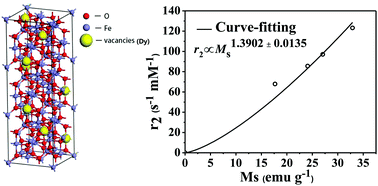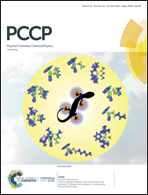Dysprosium-doped iron oxide nanoparticles boosting spin–spin relaxation: a computational and experimental study†
Abstract
Early diagnosis of diseases by contrast-enhanced magnetic resonance imaging (MRI) using iron oxide superparamagnetic nanoparticles (IOSNPs) has been extensively investigated due to the good biocompatibility of modified IOSNPs. However, the low magnetic sensitivity of IOSNPs still inflicts a certain limitation on their further application. In this study, we employed first-principles calculations based on spin-polarized density functional theory (SDFT) to find the optimal dysprosium-doped scheme for improving the magnetic sensitivity of IOSNPs. Elicited from the optimal doping scheme, we synthesized a sort of ultrasmall γ-iron oxide superparamagnetic nanoparticle by a special phase transfer-coprecipitation method. The appropriately Dy-doped γ-IOSNPs coated with short-chain polyethylene glycol are small in hydrodynamic size and highly dispersed with effectively improved superparamagnetism for enhancing T2-weighted MRI relaxivity, which is well consistent with the SDFT prediction. The measured spin–spin relaxivity r2 is 123.2 s−1 mM−1, nearly double that of the pure γ-IOSNPs (67.8 s−1 mM−1) and substantially surpassing that of both clinically-approved T2 contrast agents Feridex and Resivist. The low dysprosium doping does not induce notable nanotoxicity for IOSNPs, but contributes sufficiently to their high relaxation performance instead, which endows the Dy-doped γ-IOSNPs with high potential as a better T2-weighted MRI contrast medium. Both the method and the nanomagnets reported in this study are expected to promote studies on designing and preparing high-performance MRI contrast agents as well as computational materials.



 Please wait while we load your content...
Please wait while we load your content...